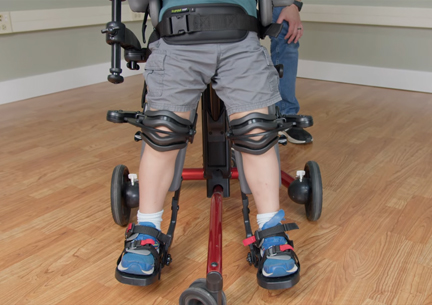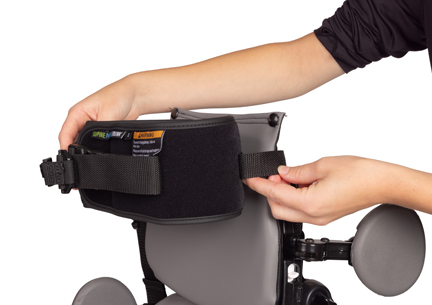FAQ on building standing skills with the Rifton Mobile stander
With regular use, the Rifton Mobile Stander provides a way for clients to build the weight-bearing and postural control skills needed for standing.
| January 2012Why is standing so important?
The physical and emotional benefits of standing are proven and extensive. They include improved bone density, prolonged stretching for tight muscles at hips, knees, and ankles, and improved function of the pulmonary and digestive systems.
Standing also provides immeasurable social benefits by enabling a client to interact at the same level as the majority of his or her peers. With opportunity and practice, the client’s ability to participate in activities of daily living expands – promoting self esteem and cognitive growth. It is truly exciting to see the increasing functional ability of a client who has been using a Mobile Stander regularly.
Read more about the benefits of standing devices for pediatric clients.
How does a Mobile Stander make activities more accessible?
When the large wheels of the Rifton Mobile Stander are removed, the client can roll right up to corners, furniture and activity areas that may be inaccessible from a wheelchair or other types of standers. Easels, sinks, tables, computers and water fountains are now within comfortable reach. Busy with these engaging tasks, clients don’t even realize they are working on weight-shifting, balance, and postural control.
In addition, an optional communication tray attached to the front of a Mobile Stander can act as a surface for lightweight table activities.
How does the Rifton Mobile Stander help a client progress toward independent standing?
With daily standing practice, the Rifton Mobile Stander helps clients improve head and trunk control and weight-bearing ability. Prompts can be removed as a client progresses toward more independent standing, for example:
- A client who initially required the optional arm prompts to maintain an upright position may over time gain sufficient strength to maintain head and upper body control with only the body support, seat pad and soft fleece strap.
- The angle of our unique, adjustable seat pad can be gradually adjusted to promote increased weight bearing through the lower extremities. The more vertically it is placed against the pelvis and lower back, the more weight a client bears on his own.
- Eventually, the soft fleece strap may no longer be needed against the client’s upper back. The body support can be lowered from shoulder-blade to waist level as the client establishes upper trunk stability.
- Rifton’s Mobile Stander also allows a client to be placed in the reverse position to help develop even greater front-to-back weight shifting and postural control. An additional seat pad can be utilized for support at the knees and trunk, and the body support can be positioned as high as needed. In this position, the client has even easier, open-front access to activities around him or her.
In time, the client may be able to bear his own weight without the stander. With minimal caregiver support for balance, or by leaning against a table or wall, the client may learn to stand on her own. At this level of postural control, many clients are able to participate in walking activities, and may begin using a Rifton Pacer or similar gait-training device.
How does the Rifton Mobile Stander enhance a client’s mobility?
With the large wheels in place, hand rims on the wheels allow many clients to easily self-propel the Mobile Stander. In fact, clients unable to propel their own wheelchairs can often discover independent movement when upright. School gym teachers love that the Mobile Stander allows children with physical challenges to participate in many games and sports. Low-level amputees, people with spina bifida, or individuals recovering from hip surgery can be upright and move freely among their peers.

The activity of self-propulsion encourages weight shifting, upper trunk and upper extremity strength, range of motion, and balance and righting responses. Independent mobility can improve spatial awareness and may even stimulate language gains. The big casters and large wheels can accommodate level outdoor surfaces for outdoor play. The locks on the large wheels can be easily reached and operated by clients with good hand use—or by a caregiver—and transparent plastic guards over the wheel spokes keep fingers safe.




